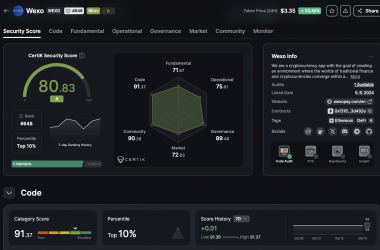
TOP bejegyzések

Wexo Points: Find places where you can pay with Bitcoin (App Up...
Search nearby businesses that accept Bitcoin payments
BővebbenBitcoin network and bitcoin mining
In order to know what bitcoin halving is, you first need to understand a little bit about how the bitcoin network and mining works.
A bitcoin network is a peer-to-peer payment network that operates based on a cryptographic protocol. It consists of a collection of computers that run bitcoin software and contain a partial or complete history of transactions occurring on its network. The transactions that users send and receive on the network are recorded in a distributed public database known as the blockchain. A blockchain is a shared database that stores data. It is often referred to as a digital ledger. The data within the blockchain is secured by encryption methods. When a transaction takes place on the blockchain, the information from the previous block is copied to a new block with new data, encrypted and the transaction is verified by validators (miners) on the network.
Mining bitcoins is a process where people use their computers to participate in the bitcoin network as a transaction processor and validator. Bitcoin uses a proof-of-work system, which means that miners must prove that they have made the effort to process transactions in order to be rewarded with a certain number of pieces worth of a given cryptocurrency. The term "mining" is not used in a literal sense, but as a reference to the way precious metals are extracted. Bitcoin miners solve complex mathematical problems and confirm the legitimacy of the transaction. They then add these transactions to a block and create chains of these block transactions, creating a blockchain.
Bitcoin halving
As an open source project, bitcoin contains code that allows what is known as a "bitcoin halving event" to occur. This line of code means that after every 210,000 blocks are mined, roughly every four years, the transaction processing reward received by bitcoin miners is halved. This event is referred to as halving because it halves the rate at which new bitcoins are released into circulation. Bitcoin thus forces synthetic price inflation until all bitcoins are released.
It can also be found in the code that at most 64 halvings will occur in the history of bitcoin. This means that a maximum of 21 million bitcoins will be created. That is, after 64 halvings, there will be no more bitcoins to be mined. This event is due to occur in 2140.
What changes occur in bitcoin halving?
Since bitcoin halving is a major event, it has a significant impact on the various parties involved in the bitcoin network.
As a result of a decrease in supply and an increase in demand, cryptocurrency prices generally increase, which is good news for investors. Thus, trading activity on the bitcoin blockchain is increasing.
However, as far as miners are concerned, fewer rewards may make it harder for individual miners or small mining organisations to survive in the bitcoin ecosystem, as it is difficult for them to compete with large mining organisations. According to research, bitcoin's mining capacity is countercyclical to its price. When the price of a cryptocurrency increases, the number of miners in its ecosystem decreases, and vice versa. A bitcoin halving event is characterised by an increase in price, but on the other hand, it can also increase the likelihood of an attack on the bitcoin network as many miners move out of its network, reducing its security.
What happens when all the bitcoins are mined?
At the end of August 2022, there were approximately 19.1 million bitcoins in circulation, leaving only approximately 1.9 million bitcoins to be released through mining rewards. Of that number, more than 3.7 million of all bitcoins have already been irretrievably lost, according to a study by Chainalysis. So what can we expect in 2140? Will miners still have an incentive to verify transactions without mining any bitcoin?
Bitcoin creator Satoshi Nakamoto predicted that in that period, and long before, miners would be motivated not only by newly mined bitcoins, but also by the fees they would charge for verifying transactions. This "motivation" was already hinted at in 2017 and the associated huge rise in the price of bitcoin. The network was so overloaded that transactions were queued for hours because miners could not verify them. This caused transaction fees to soar as miners favoured those with higher set "fees". At that time, the average fees per transaction were as high as $54.
So yes, when all the bitcoins are mined, it is assumed that the bitcoin network will continue to operate as before.
When will the next bitcoin halving occur?
The last bitcoin halving occurred on May 11, 2020. The next halving will occur on this date in 2024. From the previous reward of 6.25 BTC per block mined (once every 10 minutes on average), the reward for a successful miner who managed to solve a complicated mathematical problem will drop to 3.125 BTC. This reward will be valid for the next four years until the reward is halved again. Over time, the impact of each halving will diminish as the reward per block approaches zero.


